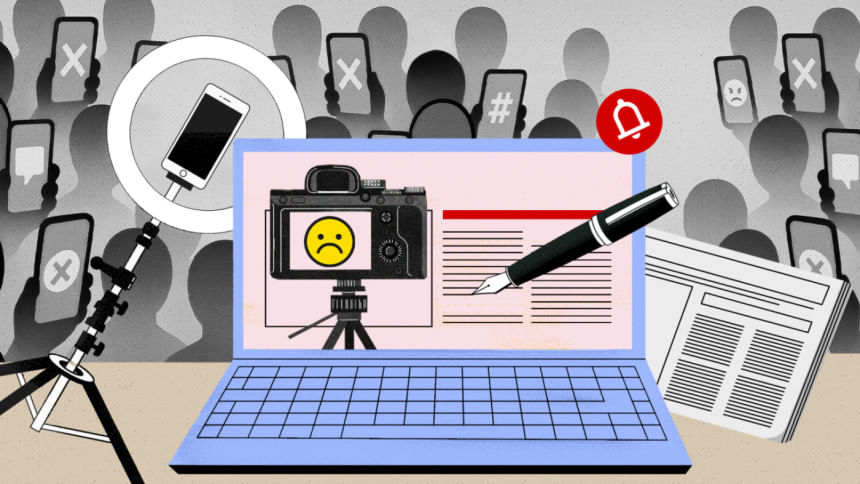31
Journalism / সাংবাদিক থেকে ইনফ্লুয়েন্সারদের আলাদা করার সময় এসেছে
« Last post by Imrul Hasan Tusher on October 07, 2025, 05:00:36 PM »সাংবাদিক থেকে ইনফ্লুয়েন্সারদের আলাদা করার সময় এসেছে

সামাজিক যোগাযোগমাধ্যম এখন সবচেয়ে শক্তিশালী মাধ্যম হিসেবে দেখা দিয়েছে। আর সেই কারণেই হয়তো নতুন করে সংজ্ঞায়িত করতে হবে সেই বহুল প্রচলিত প্রবাদ—'অসির চেয়ে মসির জোর বেশি'।
সামাজিক যোগাযোগমাধ্যমে জন্ম নিয়েছে অসংখ্য তথাকথিত 'ইনফ্লুয়েন্সার', যাদের কোনো জবাবদিহি নেই। বিভাজন বাড়ানো ও বিদ্বেষ উস্কে দেওয়াতেই তাদের সাফল্য। প্রায়শই দেখা যায়, বেপরোয়া হয়ে মিথ্যা ও অর্ধসত্যের মিশেলে তথ্য বিকৃত করে, অন্যদের বক্তব্য ভুলভাবে তুলে ধরে তারা নিজেদের উদ্দেশ্য পূরণ করে।
আর এখানেই সবচেয়ে বড় বিপদ। পেশাদার সাংবাদিকতা ও ইনফ্লুয়েন্সারদের কনটেন্টের মধ্যে থাকছে না কোনো সীমারেখা। এই ডিজিটাল যুগে সংহতি নষ্ট করার একটি মাধ্যম হয়ে দাঁড়িয়েছে এই কনটেন্টগুলো।
পেশাদার সাংবাদিক ও স্বঘোষিত ইনফ্লুয়েন্সারদের মধ্যে পার্থক্য করতে না পারায় সাধারণ মানুষ এখন সহজেই প্রভাবিত বা প্ররোচিত হচ্ছেন। বিশেষ করে রাজনৈতিক বা ব্যক্তিগত স্বার্থে মব তৈরি করা আজকের দিনে বাংলাদেশের সবচেয়ে উদ্বেগজনক ঘটনাগুলোর একটি।
পেশাদার সাংবাদিকরা সংবাদপত্র, টেলিভিশন, বেতারের মতো গণমাধ্যমে কাজ করেন, তথ্য যাচাই করেন এবং সম্পাদকীয় ও পেশাগত নীতিমালা মেনে চলেন—তারা এই সত্যের লড়াইয়ে যেন পিছিয়ে পড়ছেন।
বিপরীতে, ইনফ্লুয়েন্সাররা জনপ্রিয়তা, লাইক ও কনটেন্ট থেকে আয় করার অদম্য ক্ষুধা থেকে কখনো তথ্য বিকৃত করে, কখনো মিথ্যা তথ্য ছড়িয়ে নিজেদের উদ্দেশ্য পূরণ করছেন। অবাক করার বিষয় হলো, বহু বছরের অভিজ্ঞ সাংবাদিকদের মধ্যেও অনেকে সস্তা জনপ্রিয়তা বা রাজনৈতিক উচ্চাভিলাষ থেকে নৈতিক মানদণ্ড বিসর্জন দিয়েছেন।
বাংলাদেশে সাধারণ মানুষের মধ্যে গণমাধ্যম সচেতনতা এখনো তুলনামূলকভাবে অনেক কম। যার ফলে বিদ্বেষের বীজ বপনের উর্বর ভূমি হয়ে উঠেছে এই দেশ। রাজনীতিবিদ, শিল্পী, সংস্কৃতিকর্মী ও গণমাধ্যম ব্যক্তিত্ব—সবাই এখন অনলাইন হয়রানির ঝুঁকিতে। গঠনমূলক বিতর্ক বা অর্থবহ পাল্টা যুক্তি দেওয়ার বদলে প্রতিপক্ষকে গালিগালাজ করা, তথ্য বিকৃত করা বা কুরুচিপূর্ণ ভাষা ব্যবহারই তাদের কাছে সাধারণ চর্চা।
আওয়ামী লীগ আমলে 'রাজাকার' ছিল সবচেয়ে ভয়ংকর অপবাদ। আর এখন সেখানে জায়গা করে নিয়েছে 'ভারতের দালাল'। এই 'ডিজিটাল মব' অনেক ক্ষেত্রেই অনলাইনের গণ্ডি পেরিয়ে বাস্তব জীবনেও সহিংসতায় রূপ নিচ্ছে।
সম্প্রতি আমরা এমন বেশকিছু উদ্বেগজনক ঘটনার সাক্ষী হয়েছি—যার মধ্যে কয়েকটি সম্পূর্ণ অপ্রত্যাশিত। সন্দেহ করা হচ্ছে, বিশৃঙ্খলা তৈরি করে প্রধান উপদেষ্টার নির্বাচনী রূপরেখা ব্যাহত করতেই ইচ্ছাকৃতভাবে এসব ঘটনার অবতারণা করা হচ্ছে।
এই অশুভ প্রচেষ্টার পেছনে দুটি প্রধান শক্তিকে দায়ী করা হচ্ছে। প্রথমত, পতিত আওয়ামী লীগ সরকারের পলাতক সাংগঠনিক নেটওয়ার্ক এবং দ্বিতীয়ত, সেই সব ক্ষমতাবান ব্যক্তি বা গোষ্ঠী, যারা সামাজিক যোগাযোগমাধ্যমকে ঘৃণা ছড়ানোর ও বিভেদ সৃষ্টির অস্ত্রে পরিণত করেছে।
বাংলাদেশে এই 'ডিজিটাল মবে'র অন্যতম চারণভূমি হলো ফেসবুক ও ইউটিউব। বৈশ্বিকভাবে এই ভূমিকা পালন করছে এক্স (সাবেক টুইটার)।
সামাজিক যোগাযোগমাধ্যমের এই ধ্বংসাত্মক ব্যবহার শুধু বাংলাদেশে হচ্ছে তা না। ২০১৮ সালে জাতিসংঘের তদন্তে বলা হয়, এই প্ল্যাটফর্মগুলো মিয়ানমারে রোহিঙ্গাদের বিরুদ্ধে জাতিগত বিদ্বেষ উস্কে দিতেও ভূমিকা রেখেছে। ২০২১ সালে ফেসবুকের মূল প্রতিষ্ঠান মেটার বিরুদ্ধে রোহিঙ্গাদের বিরুদ্ধে সহিংসতা উস্কে দেওয়া ঠেকাতে ব্যর্থ হওয়ার অভিযোগে মামলা করা হয়।
সামাজিক লাঞ্ছনা নতুন কোনো প্রবণতা নয়। তবে বিস্ময়কর বিষয় হলো, যাদের সবচেয়ে বেশি লাঞ্ছিত হওয়ার কথা—যেমন: কালোবাজারি, দুর্নীতিবাজ কিংবা খাদ্যে ভেজালকারী—তারা এই 'ডিজিটাল মবে'র শিকার হন না। বরং রাজনৈতিক প্রতিপক্ষ ও সুপরিচিত ব্যক্তিদেরই পরিকল্পিতভাবে লক্ষ্যবস্তু করা হচ্ছে।
আওয়ামী লীগ যেভাবে তাদের রাজনৈতিক বিরোধীদের নিশ্চিহ্ন করার আহ্বান জানিয়ে ফ্যাসিবাদী দলে পরিণত হয়েছিল, এখন আরেকদল মানুষকে একই পথে হাঁটতে দেখা যাচ্ছে। তারাও প্রতিপক্ষকে নির্মূল করতে চায়। এই প্রবণতা চলতে থাকলে বাংলাদেশের রাজনৈতিক সংকট আরও গভীর হবে, সহিংসতা বাড়বে এবং আসন্ন জাতীয় নির্বাচনও অনিশ্চয়তার মুখে পড়তে পারে।
এই অস্থির পরিস্থিতিতে সরকারের প্রতিক্রিয়াও সন্তোষজনক নয়। উস্কানিদাতা, দাঙ্গাবাজ ও অপরাধীদের প্রতিরোধে সরকার ব্যর্থ—বিশেষ করে যারা সামাজিক যোগাযোগমাধ্যমে সক্রিয়। মাগুরায় এক শিশুকে ধর্ষণ ও হত্যার ঘটনা কিংবা মিটফোর্ডে নৃশংস হত্যাকাণ্ডের মতো কিছু ঘটনায় দ্রুত ব্যবস্থা নেওয়া হলেও অধিকাংশ ক্ষেত্রেই রাষ্ট্রকে দেখা গেছে অপ্রস্তুত কিংবা উদাসীন।
সবচেয়ে উদ্বেগজনক বিষয় হলো, ধর্মীয় বা সাম্প্রদায়িক অনুভূতিকে ব্যবহার করে ইনফ্লুয়েন্সারদের উস্কানিমূলক বক্তব্য সমাজকে অস্থিতিশীল করে তুলছে। 'মতপ্রকাশের স্বাধীনতা'র নামে সহিংসতায় উস্কানি দেওয়াও সহ্য করা হচ্ছে। সরকার বিষয়টিতে যথেষ্ট মনোযোগ দিচ্ছে বলে মনে হয় না।
অনেক সমালোচকের অভিযোগ, সরকার ইচ্ছাকৃতভাবেই এসব উস্কানিকে উপেক্ষা করছে। আমরা অনেকেই এই অভিযোগ বিশ্বাস করতে চাই না। কিন্তু চুপ করে থাকাও কোনো সমাধান নয়। কেউই চায় না যে একটি অন্তর্বর্তী সরকার ইন্টারনেট বন্ধ করবে কিংবা মতপ্রকাশের স্বাধীনতা দমন করবে। তবে আন্তর্জাতিকভাবে স্বীকৃত বিষয় হলো—অনলাইনে বিদ্বেষ ছড়ানো ও সহিংসতার উস্কানি রোধের প্রধান দায়িত্ব সরকারের। ২০২৩ সালের ১৯ ডিসেম্বর জাতিসংঘের সাধারণ পরিষদে গৃহীত দুটি প্রস্তাবেও (এ/আরইএস/৭৮/২১৪ ও এ/আরইএস/৭৮/২১৩) বিষয়টি পুনর্ব্যক্ত করা হয়েছে।
সামাজিক যোগাযোগমাধ্যম নিয়ন্ত্রণ করা সহজ নয়। কারণ, এগুলো পরিচালনা করে বহুজাতিক করপোরেশনগুলো। তারপরও, বিশ্বের বহু দেশ ইতোমধ্যে এসব প্রতিষ্ঠানকে বিলিয়ন ডলারের জরিমানা করেছে। যার ফলে তারা ক্ষতিকর কনটেন্ট প্রচারের ক্ষেত্রে কঠোর নীতি গ্রহণে বাধ্য হয়েছে।
বাংলাদেশকেও সেই পথে হাঁটতে হবে—এখনই। এসব প্রতিষ্ঠানকে জবাবদিহির আওতায় আনতে হবে, ঘৃণা ছড়ানো বা বিকৃত তথ্যের বিরুদ্ধে কার্যকর ব্যবস্থা নিতে বাধ্য করতে হবে এবং নিশ্চিত করতে হবে, ডিজিটাল মাধ্যম যেন ঘৃণা ছড়ানোর জায়গা না হয়ে ওঠে।
২০২৬ সালে নির্বাচনকে সামনে রেখে সামাজিক যোগাযোগমাধ্যমকে জবাবদিহির আওতায় আনা এখন সবচেয়ে জরুরি। সামাজিক যোগাযোগমাধ্যম নিয়ন্ত্রণ মানে মতপ্রকাশের স্বাধীনতা দমন নয়; বরং বিভাজন ও সহিংসতায় সমাজকে প্রভাবিত করা থেকে সুরক্ষিত রাখা। এভাবে আর ঘৃণা ছড়াতে দেওয়া যাবে না।
Source: https://bangla.thedailystar.net/opinion/views/news-704106


 Recent Posts
Recent Posts

